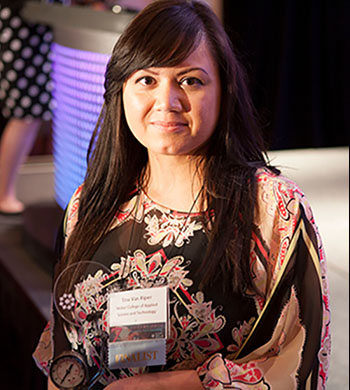WSU Computer Science Student Honored for Innovative Medical-Device Testing

Tina Van Riper, September 2014
For her work, Tina Van Riper was honored with the 2014 Academic Excellence Award on Sept. 18 from the Women Tech Council, an organization founded in Utah in 2007. The organization provides mentoring, visibility and networking for women who work for technology companies and in technology positions in other industries. Van Riper was one of five finalists from universities around the state.
A senior originally from Indonesia, Van Riper applied to work on a project that was brought to WSU by a third-party ostomy company in Chicago that designs catheters. Using MRI images of test subjects, she gathered preliminary data to create 3-D computer models of the gastrointestinal region of the human body.
“My plan was to find a way to simulate the internal workings of the lower GI region of a human body on the computer screen so companies wouldn’t have to use human or animal test subjects anymore to test out these new designs,” she said. “You can take their test designs that haven’t been created yet and integrate them into my simulations to see how they would react within the human body.”
Van Riper, who published her work in June, said that she enjoyed the challenge of the project. However, it wasn’t until her second year working on it that she realized the impact that it could have.

Van Riper with fellow recipient Kathy Philpot.
WSU computer science department chair Brian Rague said the award confirms the commitment of the department to the advancement of women in the discipline.
“Tina’s winning this award clearly demonstrates the quality of our students’ work in both contributing to research efforts and overall academic achievement,” Rague said. “She was competing with very successful and accomplished student peers and was recognized as the top student from this prestigious group. She will find success no matter what career path she chooses.”
Van Riper’s project is the first to simulate the internal workings of the lower gastrointestinal region of the human body. She foresees others expanding her work to other parts of the body.
“Now that I have been published and the information is out there, people can read and study the methodology that we came up with and see that this can be done,” she said. “Somebody else can take over, and not just for the gastrointestinal region but for any other part of the body — the heart, the brain, any part of the body that needs human simulations for any type of biomedical analytic.”
Van Riper said that she has loved computers ever since her father brought home their first computer when she was a young girl. From that day, she has enjoyed programming and hopes to continue to work in that field.
“The project was fun, and I took the job because originally I wanted to go into cancer research,” she said. “But as I was going along with this project, I was realizing that that wasn’t really the road that I wanted to go down. I really like software development and programming and those sorts of things as opposed to microbiology. It is a different path I am taking right now.”
For more information on the Women Tech Council, visit womentechcouncil.org. For more information on WSU’s computer science department, visit weber.edu/cs.
Visit weber.edu/wsutoday for more news about Weber State University.
For high-resolution photos, visit the following links:
wsuucomm.smugmug.com/Press-Release-Photos/2014-photos/September-2014/i-DXksTT6/0/XL/IMG_5069slim-XL.jpg
wsuucomm.smugmug.com/Press-Release-Photos/2014-photos/September-2014/i-86qG9d8/0/XL/IMG_5059-XL.jpg
- Marcus Jensen, Office of Marketing & Communications
801-626-7295 • marcusjensen@weber.edu - Contact:
-
Brian Rague, computer science chair
Tina Van Riper, computer science student
801-626-7377 • brague@weber.edu
385-319-9124 • tinavanriper@weber.edu